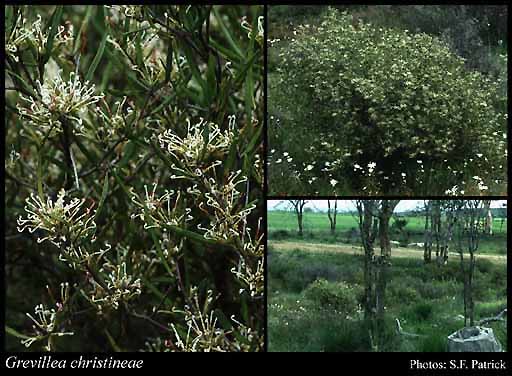- Reference
- New Names Grevillea 4 (1986)
- Conservation Code
-
Threatened
A taxon name retains its ‘Threatened’ status until a new name has been officially endorsed and appears in the Gazettal Notice.
- Naturalised Status
- Native to Western Australia
- Name Status
- Current
Erect, wiry shrub, 0.5-0.6 m high. Fl. white-cream, Aug to Sep. Clay loam, sandy clay, often moist.

Scientific Description
Shrubs, 0.5-1 m high; branchlets glabrous or hairy, not glaucous. Leaves alternate, (10-)25-60 mm long, (1-)2-5 mm wide, hairy, on the abaxial surface, the hairs straight; lamina flat, more or less the same width throughout, entire, the margins recurved. Inflorescences axillary or terminal, white; pedicels 4-5.5 mm long. Perianth 4-6 mm long; tepals all free after flower opens, hairy, simple-hairy; ovary glabrous, stipitate, the stipe 0.5-1 mm long; pistil 7-8 mm long, white or pink, pollen presenter oblique, style glabrous. Follicles glabrous, not viscid, dehiscent, 10-15 mm long. Flowers in July, August or September. Occurs in the South-west (SW) Botanical Province(s), in the Geraldton Sandplains (GS) or Avon Wheatbelt (AW) IBRA subregion(s). : Conservation code Threatened (T).
Distribution
- IBRA Regions
- Avon Wheatbelt, Geraldton Sandplains, Jarrah Forest.
- IBRA Subregions
- Geraldton Hills, Katanning, Lesueur Sandplain, Northern Jarrah Forest.
- Local Government Areas (LGAs)
- Chittering, Goomalling, Moora, Northampton, Swan.